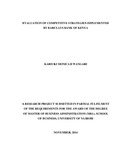| dc.description.abstract | The service sector is expanding at an increasing rate and is becoming intensely
competitive. As such, the success of a company‟s competitive strategy depends on how it
relates to its environment. The objective of the study was to evaluate the competitive
strategies adopted by Barclays Bank of Kenya and used criteria proposed by Rumelt and
focused on Porter‟s three generic strategies that describe how an organization pursues
competitive advantage across its chosen market scope which are differentiation strategy,
cost leadership strategy and focus strategy. The research design adopted was a case study
which focused on Barclays Bank of Kenya. The data collection tool was an interview
guide and seven respondents from the organization were interviewed using a Personal
Interview Guide (copy attached as Appendix I). The respondents were drawn from
middle and top management. Content analysis was used to analyze the qualitative
primary data collected. The study found that the bank used differentiation and cost
leadership and did not use focus strategy as a competitive strategy. A low-cost or cost
leadership strategy is effectively implemented when the business designs, produces, and
markets a comparable product more efficiently than its competitors. The study
established that the bank identifies customer segment and comes up with products which
are suitable for customers. The respondents indicated that the bank targets markets that
are less vulnerable to substitutes or where competition is weakest. The respondents
indicated that the bank targets markets that are less vulnerable to substitutes or where
competition is weakest. The bank differentiated itself in terms of product quality and
service, unique branding which is the mark of quality, transparency and integrity thus
resulting in reduced price elasticity, firm reputation, customer service, price
differentiation, categorizing its customers according to their needs, market segmentation
and engaging in infrastructure development. Implementation of low cost strategy was
achieved through attraction of customers through policies and procedures which enhance
the strategy, business plan formulated on low cost strategy and continuous innovation of
new customer friendly products. It was recommended that the bank further reduces
overhead costs through streamlining operations. It was also recommended that the bank
could study market trends on pricing to enable it price competitively. | en_US |

